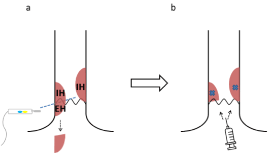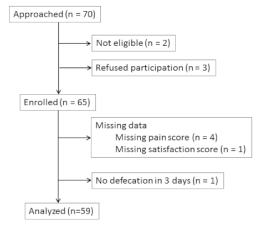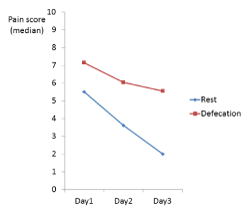Abstract
Aim: The major problem after hemorrhoidectomy is postoperative pain. This study was designed to investigate the hypothesis that the pain will be reduced as the resection wound is smaller. Aluminum potassium sulphate and tannic acid (ALTA) injection sclerotherapy was performed on the internal hemorrhoid component and the external hemorrhoid component was resected.
Methods: 59 patients with Grade 3 or 4 hemorrhoids who underwent ALTA sclerotherapy with complementary resection were included for the analysis. The patients were asked to record their pain for 3 days after surgery. Outcome measures included maximal pain score (0–10), time off work, and patient satisfaction score (-3 to +3). This is a prospective, observational and single arm study.
Results: The median maximal pain score was 7.4 [interquartile range (IQR), 5.4–9.0], the median time off work was 3 days (IQR, 2–4 days), and the median patient satisfaction score was +3 (IQR, 2.5–3.0).
Conclusion: Minimizing the extent of resection by performing thorough sclerotherapy may reduce pain a few days after surgery and expedite the return to work.
Introduction
Hemorrhoidectomy, which is the most common treatment method for Grade 3 or 4 hemorrhoids [1], involves the resection of both internal and external hemorrhoids, resulting in intense postoperative pain [2]. In contrast, aluminium potassium sulphate and tannic acid (ALTA) injection sclerotherapy, which is an effective treatment for internal hemorrhoids that is widely used in Japan [3], causes minimal pain [4]. We hypothesised that decreasing the size of resection wound is a key in reducing postoperative pain; thus, ALTA injection would be effective in decreasing the wound size. More specifically, we hypothesised that pain reduction can be achieved by injecting ALTA to eliminate all wounds located oral to the dentate line. In this study, we performed two different treatments on each hemorrhoid—injection and hemorrhoid resection—on each side of the dentate line as a border and investigated post-treatment pain.
Methods
Patients
This was a prospective study conducted on patients who underwent two different treatments, injection and hemorrhoid resection, for Grade 3–4 hemorrhoids between July 2017 and February 2018 at Yano Proctological Clinic in Takamatsu, Japan. Patients with a concomitant anal fistula or fissure, history of anal surgery, ongoing pregnancy, or inflammatory bowel disease were excluded from the study. Those who did not consent to the study even after receiving an explanation, those who consented to participate in the study but had incomplete records, and those who had no bowel movement for 3 days were also excluded.
Ethics and permissions
The study protocol was approved by the independent ethics committee of the Japan Medical Association Ethical Review Board (approval number 29-2) on 27th June 2017. The study is registered under the Medical Information Network and Clinical Trials Registry (JMACCT-CTR Number IIA00308) and performed according to the Declaration of Helsinki. Written informed consent was obtained from all participants prior to inclusion in the study.
Surgical procedure
All surgeries were performed as day cases with patients in the Sims position under local anaesthesia via 20 mL injection of 1.0% lidocaine into the anal verge and submucosa of the anal canal. Immediately after the administration of local anaesthetic, a surgeon confirmed the location of the symptomatic hemorrhoids in relation to the dentate line using a proctoscope. The surgeon determined the treatment for each hemorrhoid on the basis of its location and performed one of the following three procedures: (1) hemorrhoids located oral to the dentate line were treated using only ALTA injection sclerotherapy; (2) when a hemorrhoid to be treated was positioned across the dentate line, external hemorrhoid component was resected and then ALTA injection sclerotherapy was performed on the remaining internal hemorrhoid component and (3) hemorrhoids located anal to the dentate line were treated using only resection.
Any external hemorrhoids located lateral to the dentate line were detached from the anal epithelium as far as the dentate line and resected using the diathermy. This process was repeated for all external hemorrhoids. Any skin tags, polyps, or thrombi accompanying the external hemorrhoid components were included in the scope of resection. Next, a proctoscope was inserted to directly view any internal hemorrhoids, which were injected with ALTA solution via a 25-gage needle inserted into the submucosal layer of the internal hemorrhoid. This process was performed for all internal hemorrhoid components. Surgery began when the local anaesthetic was first injected and ended once all ALTA injection sclerotherapies were completed. The duration of surgery was also recorded. Recorded treatment details included the number of internal hemorrhoids that received ALTA injection, number of external hemorrhoids resected, whether the external hemorrhoid that was resected and the internal hemorrhoid that received injection were continuous and the amount (mL) of ALTA solution used per patient. For example, when one of two hemorrhoids had an external hemorrhoid component, ALTA was injected at two locations and external hemorrhoid resection was performed only at one location. Such a case was referred to as ALTA2 and external hemorrhoid resection (EHR)1 and is graphically illustrated in figure 1.

Figure 1. Schematic diagram of the procedure for resection of two hemorrhoids. Aluminium potassium sulphate and tannic acid (ALTA) injection sclerotherapy is performed on internal hemorrhoid components and external hemorrhoid resection (EHR) is performed on one external hemorrhoid component. They are named ‘ALTA2 and EHR1’. a. The external hemorrhoid component is removed at the dentate line. b. ALTA injection is administered on the remaining internal hemorrhoid components. IH, internal hemorrhoid; EH, external hemorrhoid
Wounds were left open, and no sponge dressing was placed in the anal canal after surgery. All procedures were performed by the same experienced surgeon. The wound was visually checked for hemostasis 1 h after surgery, and the patient was discharged for home.
Postoperative care
All patients were assigned the following countermeasures against pain at home. Patients were asked to take an oral non-steroidal anti-inflammatory drug, loxoprofen sodium hydrate (60 mg/tablet), at 5-hour intervals, as needed whenever they experienced pain. They were also asked to take an oral laxative, magnesium hydroxide (660 mg/day), for 7 days after surgery and were strongly recommended to consume dietary fiber and plenty of fluids as well as take hot baths.
Assessments
This study investigated the level of pain for 3 days after surgery based on a report suggesting that postoperative pain is the highest over the first 3 days after hemorrhoid surgery [5]. Patients recorded their own pain level once daily at bedtime, and bedtime on the day of surgery was recorded as Day 1. A nurse not connected to this study distributed the recording forms to the patients before surgery and instructed the patients on how to record their pain level. The patients drew two 10-cm straight lines each day on the recording form and rated their level of pain on a scale of 0–10 (0 cm representing no pain at all, 10 cm representing the worst pain imaginable).
The first line represented the greatest level of pain while at rest, and the second line represented the greatest level of pain while defecating on that day. On days without bowel movement, the second line was not recorded. Two months after surgery, the patients were followed up every 2 weeks and the number of days they missed work because of surgery and follow-ups were recorded. In addition, 6 weeks after surgery, the patients were asked to record their level of patient satisfaction using a visual analog scale from −3 (very dissatisfied) to +3 (very satisfied).
Outcomes and definitions
The primary outcome measure was maximal pain score, whereas secondary outcome measures included time off work, duration of surgery, patient satisfaction score 6 weeks after surgery, and complications. Maximal pain score was defined as the highest pain score recorded by each patient over the 3 days after surgery. In addition, patients who did not record any second lines over the 3 days were considered to have not experienced any bowel movement and were assigned the label “no defecation in 3 days.”
Statistical analysis
Non-parametric data were presented as median and interquartile range (IQR), and parametric data were presented as mean ± standard deviation (s.d.).
Results
A flowchart of the patients is presented in Figure 2. Both ineligible patients had a concomitant anal fissure. Patient characteristics and treatments performed are presented in Tables 1 and 2. Resected external hemorrhoids were always continuous with the internal hemorrhoids that received injections. The median maximal pain score was 7.4 (IQR, 5.4–9.0); the median pain score at rest was 5.5 (IQR, 2.6–7.7) on Day 1, 3.6 (IQR, 1.8–5.9) on Day 2, and 2.0 (IQR, 0.95–3.8) on Day 3; and the median pain score at defecation was 6.5 (IQR, 5.0–8.9) on Day 1 (n = 36), 6.0 (4.5–8.1) on Day 2 (n = 50), and 5.6 (IQR, 3.9–7.7) on Day 3 (n = 54; Figure 3). In total, 36 patients defecated on Day 1, 50 on Day 2, and 54 on Day 3. Only one patient did not defecate in 3 days, and this patient had a maximal pain score of 8.1. The median time off work was 3 days (IQR, 2–4 days; Figure 4). The mean duration of surgery was 23 (±4.1) min, the median volume of ALTA solution administered was 15 (IQR, 10–20) mL, and the median patient satisfaction score was +3 (IQR, 2.5–3.0). One patient needed to be hospitalized due to intense pain. This patient had undergone ALTA2 and EHR2 while taking 12 days off from work and had a maximal pain score of 10.0. The major complications observed were anal stenosis in two patients and rectal ulcer in two patients, and no postoperative bleeding was noted. None of these complications required repeat surgery.

Figure 2.Study flow chart

Figure 3. Changes in a median of pain score at rest and at defecation in the first 3 days

Figure 4. Number of patients according to time off work
Table 1. Patients characteristics. (Values in parentheses are percentages unless otherwise indicated; *values are median (interquartile range)
No. of patients |
59 |
Age (years)* |
43 (37–53) |
Sex |
|
M |
21 (36%) |
F |
38 (64%) |
Hemorrhoid grade |
|
III |
9 (15%) |
IV |
50 (85%) |
Table 2. Type of treatment in the study. Data are the number of patients with percentages in parentheses. DHA, distal hemorrhoidectomy with ALTA sclerotherapy; ALTA, aluminum potassium sulfate and tannic acid.
No. of DHA performed |
No. of ALTA sclerotherapy performed without resection |
n (%) |
1 |
0 |
7 (12) |
|
1 |
7 (12) |
|
2 |
2 (3.4) |
2 |
0 |
22 (37) |
|
1 |
20 (34) |
3 |
0 |
1 (1.7) |
Discussion
In this study, we used an injection to decrease the size of the resection wound and thereby reduce the pain. Several results from this study suggested that after this treatment, pain rapidly reduces to a level where the patient can return to work on day 3, although it is intense immediately after treatment. First, the maximal pain score was 7.4, which is >6.2 that has been reported for common hemorrhoidectomy [6]. This increased pain may be because the ALTA injection itself caused pain, although it may have reduced pain from resection wounds. Hachiro previously reported that 10.7 per cent of patients who received ALTA injection required analgesics [4]; therefore, ALTA injection can be recognised as a mildly painful treatment. Next, the median time off work was 3 days, which is far shorter than 8–16 days that has been reported for conventional hemorrhoidectomy [7,8]; however, this may be due to Japan’s social environment, wherein a long-term time off is difficult to take. Furthermore, the resting pain score was 2.0 on day 3. For conventional hemorrhoidectomy, it has been reported that a pain score of 1.4 allows patients to return to their work [7]. The 2.0 score obtained in the study does not appreciably differ from the reported 1.4 score and can be regarded as a level at which patients can return to their work. In addition, compared with the resting pain score on day 3 after conventional hemorrhoidectomy that has been reported to be 5.0 [9], the 2.0 score observed in the present study is clearly smaller, indicating that the pain decreased in a shorter period.
There are several plausible reasons why the pain decreased. In addition to the pain reduction by ALTA injection, we speculate that the reduced size (because resection was limited to the anal side from the dentate line) and decreased number (because resection was not performed when lesions did not have any external hemorrhoid component) of resection wounds also contributed to the reduced pain. Typically, most hemorrhoid surgeries involve the resection of three hemorrhoids [10]. However, only one patient in the present study received EHR3, whereas other patients who received treatment for three hemorrhoids likely underwent ALTA3 and EHR1 or ALTA3 and EHR2, which would have decreased the number of wounds to one or two instead of three.
The mean duration of surgery of 23 min in this treatment did not considerably differ from 25 min reported in conventional hemorrhoid surgery in a previous study [10]. In terms of patients’ satisfaction score at 6 weeks after surgery, the score of +3.0 for this treatment was not considerably different from that of +2.3 reported for conventional hemorrhoidectomy in a previous study [7].
Aside from the present study, Abe [11] was the only one who has reported a treatment method combining injection and surgical resection. This paper differs from Abe’s paper in that the internal hemorrhoid was a treatment target of this method, which was not a target of Abe’s treatment. The two studies also differ in terms of outcomes—pain in this treatment and therapeutic efficacy in Abe’s treatment.
The treatment described in the present study may become an alternate option for patients suffering from hemorrhoids because of its potential for allowing an early return to work. Moreover, no additional technique is required to perform this treatment, apart from a surgeon's eyes to determine the position of the lesion (across the dentate line or not) and an increased awareness of ALTA injection sclerotherapy as being an excellent treatment. While the former does not take too long to master, the latter may require some time primarily because of three reasons: first, ALTA solution is an unfamiliar drug because its distribution is limited to Asia; second, to date, only few studies have reported excellent therapeutic outcomes for ALTA injection sclerotherapy [3,4] and third, several physicians will likely lack confidence in their ability to perform sclerotherapy because of the very poor therapeutic outcomes of the earlier phenol in almond oil sclerotherapy [12,13].
Conclusion
This study has several limitations, including the small sample size, absence of a control group, short follow-up, inclusion of patients from a single clinic, and surgeries performed by just one surgeon. Furthermore, the sample was limited to the patients with both internal and external hemorrhoid components.
Consent
Informed consent was obtained from all participants included in the study.
Conflicts of interest
The author declares no conflicts of interest.
Acknowledgement
The author thanks Dr. Michio Asano for his useful advice.
References
- Simillis C, Thoukididou SN, Slesser AA, Rasheed S, Tan E, et al. (2015) Systematic review and network meta-analysis comparing clinical outcomes and effectiveness of surgical treatments for hemorrhoids. Br J Surg 102: 1603-1618.
- Joshi GP, Neugebauer EA (2010) PROSPECT Collaboration. Evidence-based management of pain after hemorrhoidectomy surgery. Br J Surg 97: 1155-1168.
- Miyamoto H, Hada T, Ishiyama G, Ono Y, Watanabe H, et al. (2016) Aluminum potassium sulfate and tannic acid sclerotherapy for Goligher Grades II and III hemorrhoids: Results from a multicenter study. World J Hepatol 8: 844-849.
- Hachiro Y, Kunimoto M, Abe T, Kitada M, Ebisawa Y, et al. (2011) Aluminum potassium sulfate and tannic acid (ALTA) injection as the mainstay of treatment for internal hemorrhoids. Surg Today 41: 806-809.
- Gravie JF1, Lehur PA, Huten N, Papillon M, Fantoli M, et al. (2005) Stapled hemorrhoidopexy versus milligan-morgan hemorrhoidectomy: a prospective, randomized, multicenter trial with 2-year postoperative follow up. Ann Surg 242: 29-35. [Crossref]
- Luo CH, Zang CB, Zhang GK, Liu HY (2010) Haemorrhoidectomy by vessel sealing system under local anesthesia in an outpatient setting: preliminary experience. Colorectal Dis 12: 236-240.
- Kairaluoma M, Nuorva K, Kellokumpu I (2003) Day-case stapled (circular) vs. diathermy hemorrhoidectomy: a randomized, controlled trial evaluating surgical and functional outcome. Dis Colon Rectum 46: 93-99.
- Muzi MG, Milito G, Nigro C, Cadeddu F, Andreoli F, et al. (2007) Randomized clinical trial of LigaSure and conventional diathermy hemorrhoidectomy. Br J Surg 94: 937-942.
- Balta AZ, Ozdemir Y, Sucullu I, Filiz AI, Yucel E, et al. (2015) The effect of early warm plastic bag application on postoperative pain after hemorrhoidectomy: a prospective randomized controlled trial. Am Surg 81: 182-186.
- Khan RN, Jindal V, Kapoor S, Panwar R, Bansal VK, et al. (2010) Randomized clinical trial of symptom control after stapled anopexy or diathermy excision for haemorrhoid prolapse. J Surg 97: 167-176 [Crossref]
- Abe T, Hachiro Y, Ebisawa Y, Hishiyama H, Kunimoto M (2014) Distal hemorrhoidectomy with ALTA injection: a new method for hemorrhoid surgery. Int Surg 99: 295-298. [Crossref]
- Greca F, Hares MM, Nevah E, Alexander-Williams J, Keighley MR, et al. (1981) A randomized trial to compare rubber band ligation with phenol injection for treatment of hemorrhoids. Br J Surg 68: 250-252.
- Santos G, Novell JR, Khoury G, Winslet MC, Lewis AA, et al. (1993) Long-term results of large-dose, single-session phenol injection sclerotherapy for hemorrhoids. Dis Colon Rectum 36: 958-961. [Crossref]




